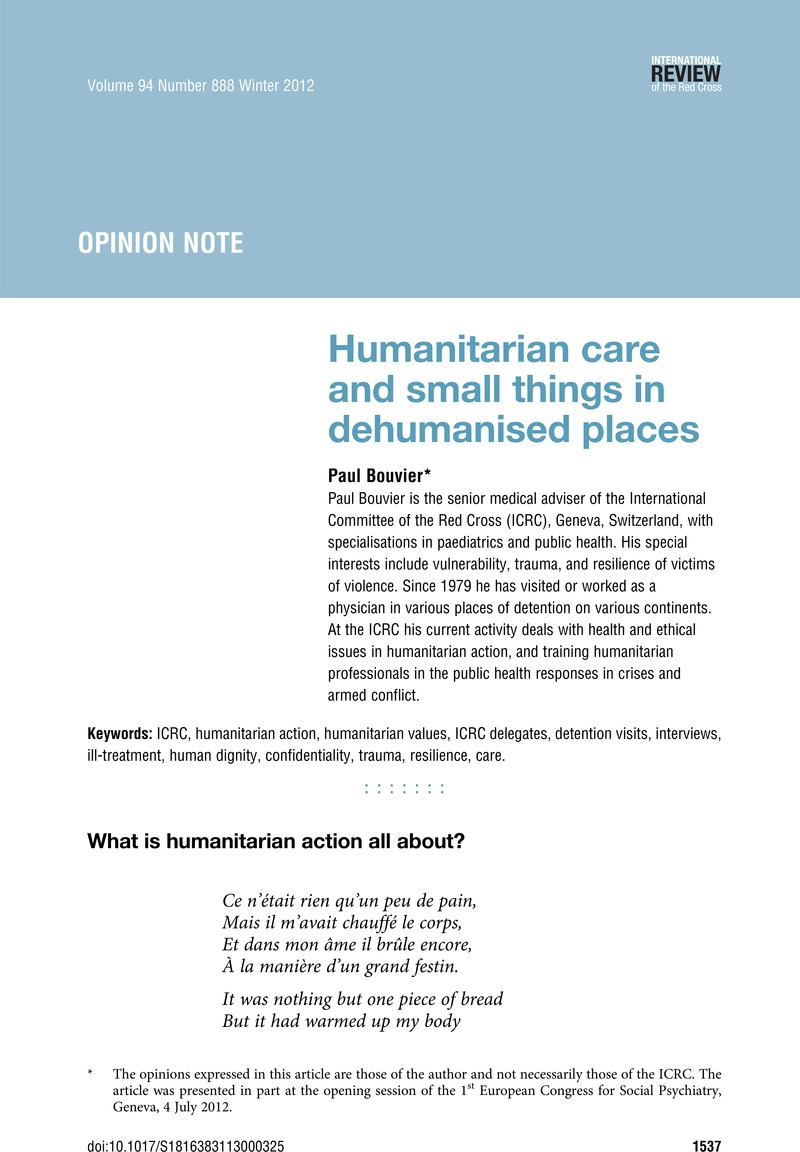Article contents
Humanitarian care and small things in dehumanised places
Published online by Cambridge University Press: 15 August 2013
Abstract

Keywords
- Type
- Comments and Opinions
- Information
- International Review of the Red Cross , Volume 94 , Issue 888: ICRC: 150 years of Humanitarian Action , December 2012 , pp. 1537 - 1550
- Copyright
- Copyright © International Committee of the Red Cross 2013
References
1 ICRC, Visiting Detainees, ICRC, Geneva, 2013Google ScholarPubMed, available at: http://www.icrc.org/eng/what-we-do/visiting-detainees/ (last visited 22 June 2013). See also the leaflet Ensuring respect for the life and dignity of persons deprived of their liberty, ICRC, Geneva, 2011, available at: http://www.icrc.org/eng/resources/documents/publication/p0543.htm (last visited February 2013).
2 Bouvier, Paul, ‘“Yo lo vi” – Goya witnessing the disasters of war: an appeal to the sentiment of humanity’, in International Review of the Red Cross, Vol. 93, No. 884, December 2011, pp. 1107–1133CrossRefGoogle Scholar.
3 ICRC, ‘Respect for the life and dignity of the detainees’, Overview, 29 October 2010, available at: http://www.icrc.org/eng/what-we-do/visiting-detainees/overview-visiting-detainees.htm (last visited 22 June 2013).
4 ICRC, ‘Remembering the silence’, ICRC, Geneva, 1993, DVD, 34 min.
5 Red Cross messages (RCM) are open letters that contain exclusively family or private news, and are collected and delivered personally by volunteers of the National Society of the Red Cross or Red Crescent, or by staff of the ICRC. The RCM contain the name and full address of the sender and the addressee and, in places of detention, they are read by the authorities before delivery. See ICRC, ‘Restoring contact’, available at: http://familylinks.icrc.org/en/Pages/HowWeWork/restoring-contact.aspx (last visited 22 June 2013).
6 Ricœur, Paul, ‘L’échange des dons et la reconnaissance mutuelle’, in Parcours de la reconnaissance, Stock, Paris, 2004, pp. 342 and 352Google Scholar; Ricœur, Paul, The Course of Recognition, Harvard University Press, Cambridge MA, 2005Google Scholar.
7 Mollica, Richard F., Healing Invisible Wounds: Paths to Hope and Recovery in a Violent World, Harcourt Inc., Orlando FL, 2006, p. 31Google Scholar.
8 Hernández, Pilar, Gangsei, David and Engstrom, David, ‘Vicarious resilience, a new concept in work with those who survive trauma’, in Family Process, Vol. 46, No. 2, June 2007, p. 231CrossRefGoogle ScholarPubMed.
9 Dekel, Rachel and Solomon, Zahava, ‘Secondary traumatization among wives of Israeli POWs: the role of POWs’ distress’, in Social Psychiatry and Psychiatry Epidemiology, Vol. 41, No. 1, 2006, pp. 27–33CrossRefGoogle ScholarPubMed.
10 Engstrom, David W., Roth, Tova and Hollis, Jennie, ‘The use of interpreters by torture treatment providers’, in Journal of Ethnicity and Cultural Diversity in Social Work, Vol. 19, No. 1, January–March 2010, pp. 54–72CrossRefGoogle Scholar.
11 Vrklevski, Lila Petar and Franklin, John, ‘Vicarious trauma: the impact on solicitors of exposure to traumatic material’, in Traumatology, Vol. 14, No. 1, March 2008, pp. 106–118CrossRefGoogle Scholar.
12 P. Hernández et al., above note 8, p. 230.
13 Hernández, Pilar, Engstrom, David, and Gangsei, David, ‘Exploring the impact of trauma on therapists: vicarious resilience and related concepts in training’, in Journal of Systemic Therapies, Vol. 29, No. 1, 2010, p. 73CrossRefGoogle Scholar.
14 Siniavski, André, ‘« MOI» ET «EUX». Sur quelques formes extrêmes de la communication dans des conditions de solitude’, in Solitude et Communication, Rencontres Internationales de Genève – Tome XXV, Éditions de la Baconnière, Neuchâtel, 1975, pp. 137–167Google Scholar.
15 Idem., p. 138.
16 Ibid., p. 145.
17 Ibid., p. 145.
18 Wee, Lionel, ‘Extreme communicative acts and the boosting of illocutionary force’, in Journal of Pragmatics, Vol. 36, No. 12, December 2004, pp. 2161–2178Google Scholar; Wee, Lionel, ‘The hunger strike as a communicative act: intention without responsibility’, in Journal of Linguistic Anthropology, Vol. 17, No. 1, June 2007, pp. 61–76Google Scholar.
19 Glover, Jonathan, Humanity: A Moral History of the Twentieth Century, Pimlico, London, 1999Google Scholar.
20 Idem., pp. 22–23.
21 Ibid., p. 383.
22 Ibid., p. 383.
23 Améry, Jean, Par-delà le crime et le châtiment – Essai pour surmonter l'insurmontable, Actes Sud, Arles, 1995 (translated from German), p. 159Google Scholar.
24 Idem., pp. 172 and 208.
25 Hollander-Lafon, Magda, Quatre petits bouts de pain – des ténèbres à la joie, Albin-Michel, Paris, 2012Google Scholar.
26 Idem., p. 90.
27 Ibid., p. 34.
28 Ibid., p. 45.
29 Ibid., p. 51.
30 Ibid., p. 73.
- 8
- Cited by




